Taxonomical Analysis of Alternative Energy Sources Application in Road Transport in the European Union Countries
Abstract
1. Introduction
- Mandatory national targets: Member States are required to provide an appropriate number of publicly accessible charging and refueling points for alternative fuels, distributed proportionally to the number of vehicles using these fuels.
- Common technical specifications: Uniform technical standards for alternative fuels infrastructure have been established to ensure interoperability and ease of use throughout the European Union.
- Information requirements and payments: Infrastructure operators are required to provide users with transparent information on availability, prices, and payment options in an easy and non-discriminatory way.
- National policy frameworks: Each Member State must develop and submit to the European Commission a national policy framework for the development of the alternative fuels market and plans for the deployment of the relevant infrastructure.
- Reporting mechanism: A system for regular reporting on progress towards the targets has been introduced to monitor and support the coherent development of infrastructure across the Union.
- Electric vehicles (BEV)—they use energy stored in lithium-ion or other batteries and are charged using electricity from the power grid and plug-in hybrid PHEV cars, combining an electric drive with an internal combustion engine in a configuration that allows charging from the grid and driving in purely electric or hybrid modes.
- Hybrid cars (HEV, MHEV)—these cars combine an internal combustion engine with an electric engine, which allows fuel savings and CO2 reduction. They are chosen as an alternative to combustion vehicles, especially in cities.
- Hydrogen cars (FCEV)—they use fuel cells that convert hydrogen into electricity, and the exhaust gases are only water vapor.
- Biofuel cars—fuels are produced in liquid or gaseous forms from biomass (agricultural waste, algae, or oil plants).
- Gas cars (CNG, LNG, LPG)—CNG is compressed natural gas used in passenger cars, buses, and trucks, and LNG is liquefied gas used mainly in sea and truck transport.
- Solar cars—they use photovoltaic panels to generate electricity; solar energy can be a supplement to electric cars.
- How is the market for alternative energy sources in transport developing in individual EU countries?
- What is the infrastructure and what types of fuels are the countries being studied investing in?
- Is there any differentiation between countries in terms of introducing new technologies?
- Which countries are best positioned on the new path of automotive development, and which have the greatest difficulties?
2. Literature Review
3. Materials and Methods
- It is expected that all diagnostic variables will be treated as stimulants or de-stimulants. The features characterized as nominants will be converted to corresponding stimulant values by the following transformation:
- 2.
- The matrix of normalized values for diagnostic variables is determined using the Unitarization procedure (aimed at transforming the values of all diagnostic variables to their comparable values in the interval [0,1]):
- 3.
- Three variants of the ranking were applied. In the first variant, the same weights were assumed for all diagnostic variables, taking into account their equal contribution to the rankings, while in the second variant, an individual weight system was adopted for each diagnostic variable . The weights were determined according to the formula , where is the percentage coefficient of variation for the j-th diagnostic variable. Therefore, the variable made a greater contribution to the ranking; the greater its variability, the more it differentiated the studied objects [71]. The third variant of determining the contribution of diagnostic variables to the final value of the aggregated TOPSIS measure consisted of determining weights using the CRiteria Importance Through Intercriteria Correlation (CRITIC) method. The normalized values for the ranking variant with different weights were, therefore, multiplied by their corresponding weights , while, for the ranking version with equal weights, it was assumed .
- 4.
- Coordinates for pattern vector (ideal solution) for optimum values of diagnostic variables and anti-pattern vector (anti-ideal solution) for the worst values of diagnostic variables are determined according to the following formulas:
- 5.
- The distances of the i-th object from the formula and anti-formula were determined. The calculations used the EDM (Euclidean distance measure) as follows:
- 6.
- An aggregate measure (ranking index) corresponding to the degree of similarity of the investigated objects to the ideal solution is determined according to the following formula:
- 7.
- The objects are placed in a decreasing order depending on the value of measure , and the final ranking is generated for the objects (European Union countries). The greater the values of the calculated synthetic index for the country, the higher the country’s position in the ranking.
- A matrix of taxonomic distances is determined (the Euclidean distance is assumed in the calculations, as in the TOPSIS method) with dimensions , which represents the distance of each pair of objects from each other. This matrix is a symmetric matrix with respect to the main diagonal, which contains zeros.
- A pair of object indices (“p” and “q”, p < q) is found, and in further iterations of the algorithm, the components of the clusters for which the mutual distance is minimal.
- The objects (or clusters) “p” and “q” are combined into one new cluster, which occupies the position with the number “p”. At the same time, the object (cluster) with the number “q” is removed, and the numbers of the clusters with a number higher than it are reduced by one. In this way, the dimension of the distance matrix is reduced by 1.
- The distance of the newly created cluster from each remaining cluster “r” is determined (r takes values different from p and q) according to the following formula:
4. Results
Characteristics of Diagnostic Variables Used in the Research
- Battery Electric Light-Duty Vehicles (BEV): Each BEV registered in a Member State must be served by a minimum total power output of 1.3 kW from publicly accessible charging stations.
- Plug-in Hybrid Electric Vehicles (PHEV): Each registered PHEV must have a minimum total power output of 0.8 kW from publicly accessible charging stations.
5. Discussion
6. Conclusions
6.1. Main Conclusions from the Research
6.2. Implications for Transport Policy
6.3. Research Limitations and Directions for a Further Analysis
6.4. Challenges and the Future
Author Contributions
Funding
Data Availability Statement
Conflicts of Interest
References
- Razmjoo, A.; Ghazanfari, A.; Jahangiri, M.; Franklin, E.; Denai, M.; Marzband, M.; Astiaso Garcia, D.; Maheri, A. A comprehensive study on the expansion of electric vehicles in Europe. Appl. Sci. 2022, 12, 11656. [Google Scholar] [CrossRef]
- Regulation (EU) 2023/1804 of the European Parliament and of the Council of 13 September 2023, On the Deployment of Alternative Fuels Infrastructure, and Repealing Directive 2014/94/EU, (Text with EEA Relevance), Official Journal of the European Union, EUR-LEX. Available online: https://eur-lex.europa.eu/legal-content/EN/TXT/PDF/?uri=CELEX:32023R1804 (accessed on 21 February 2025).
- Proposal for a Regulation of the European Parliament and of the Council on the Deployment of Alternative Fuels Infrastructure, and Repealing Directive 2014/94/EU of the European Parliament and of the Council COM/2021/559 Final. EUR-LEX. Available online: https://eur-lex.europa.eu/legal-content/EN/TXT/?uri=celex:52021PC0559 (accessed on 21 February 2025).
- Muratori, M.; Alexander, M.; Arent, D.; Bazilian, M.; Cazzola, P.; Dede, E.M.; Farrell, J.; Gearhart, C.; Greene, D.; Jenn, A.; et al. The rise of electric vehicles—2020 Status and future expectations. Prog. Energy 2021, 3, 022002. [Google Scholar] [CrossRef]
- Hu, Y.; Wang, Z.; Li, X. Impact of policies on electric vehicle diffusion: An evolutionary game of small world network analysis. J. Clean. Prod. 2020, 265, 121703. [Google Scholar] [CrossRef]
- Soares, L.O.; da Cunha Reis, A.; Vieira, P.S.; Hernández-Callejo, L.; Boloy, R.A.M. Electric vehicle supply chain management: A bibliometric and systematic review. Energies 2023, 16, 1563. [Google Scholar] [CrossRef]
- Ullah, I.; Safdar, M.; Zheng, J.; Severino, A.; Jamal, A. Employing bibliometric analysis to identify the current state of the art and future prospects of electric vehicles. Energies 2023, 16, 2344. [Google Scholar] [CrossRef]
- Filho, W.L.; Abubakar, I.R.; Kotter, R.; Grindsted, T.S.; Balogun, A.-L.; Salvia, A.L.; Aina, Y.A.; Wolf, F. Framing electric mobility for urban sustainability in a circular economy context: An overview of the Literature. Sustainability 2021, 13, 7786. [Google Scholar] [CrossRef]
- Anastasiadou, K.; Gavanas, N. State-of-the-Art review of the key factors affecting electric vehicle adoption by consumers. Energies 2022, 15, 9409. [Google Scholar] [CrossRef]
- Omahne, V.; Knez, M.; Obrecht, M. Social aspects of electric vehicles research—Trends and relations to sustainable development goals. World Electr. Veh. J. 2021, 12, 15. [Google Scholar] [CrossRef]
- Sendek-Matysiak, E.; Łosiewicz, Z. Analysis of the development of the electromobility market in Poland in the context of the Implemented subsidies. Energies 2021, 14, 222. [Google Scholar] [CrossRef]
- Adamczyk, J.; Dzikuć, M.; Dylewski, R.; Varese, E. Assessment of selected environmental and economic factors for the development of electro-mobility in Poland. Transportation 2024, 51, 2199–2223. [Google Scholar] [CrossRef]
- Sobiech-Grabka, K.; Stankowska, A.; Jerzak, K. Determinants of electric cars purchase intention in Poland: Personal attitudes v. economic arguments. Energies 2022, 15, 3078. [Google Scholar] [CrossRef]
- Lewicki, W.; Drożdż, W. Electromobility and its development prospects in the context of Industry 4.0: A comparative study of Poland and the European Union. Eur. Res. Stud. J. 2021, 24, 135–144. [Google Scholar] [CrossRef]
- Tucki, K.; Orynycz, O.; Dudziak, A. The impact of the available infrastructure on the electric vehicle market in Poland and in EU countries. Int. J. Environ. Res. Public Health 2022, 19, 16783. [Google Scholar] [CrossRef] [PubMed]
- Łuszczyk, M.; Sulich, A.; Siuta-Tokarska, B.; Zema, T.; Their, A. The development of electromobility in the European Union: Evidence from Poland and cross-country comparisons. Energies 2021, 14, 8247. [Google Scholar] [CrossRef]
- Sendek-Matysiak, E.; Grysa, K. Assessment of the total cost of ownership of electric vehicles in Poland. Energies 2021, 14, 4806. [Google Scholar] [CrossRef]
- Brodowicz, D.P.; Stankowska, A. European Union’s goals towards electromobility: An assessment of plans’ implementation in Polish cities. Eur. Res. Stud. J. 2021, 24, 645–665. [Google Scholar] [CrossRef]
- Połom, M.; Wiśniewski, P. Implementing electromobility in public transport in Poland in 1990–2020. A review of experiences and evaluation of the current development directions. Sustainability 2021, 13, 4009. [Google Scholar] [CrossRef]
- Guzik, R.; Kołoś, A.; Taczanowski, J.; Fiedeń, Ł.; Gwosdz, K.; Hetmańczyk, K.; Łodziński, J. The second generation electromobility in Polish urban public transport: The factors and mechanisms of spatial development. Energies 2021, 14, 7751. [Google Scholar] [CrossRef]
- Emanović, M.; Jakara, M.; Barić, D. Challenges and opportunities for future BEVs adoption in Croatia. Sustainability 2022, 14, 8080. [Google Scholar] [CrossRef]
- Mutavdžija, M.; Kovačić, M.; Buntak, K. Assessment of selected factors influencing the purchase of electric vehicles—A case study of the Republic of Croatia. Energies 2022, 15, 5987. [Google Scholar] [CrossRef]
- Gomółka, K.; Kasprzak, P. Directions and prospects for the development of the electric car market in selected ASEAN countries. Energies 2021, 14, 7509. [Google Scholar] [CrossRef]
- Ala, G.; Colak, I.; Di Filippo, G.; Miceli, R.; Romano, P.; Silva, C.; Valtchev, S.; Viola, F. Electric mobility in Portugal: Current situation and forecasts for fuel cell vehicles. Energies 2021, 14, 7945. [Google Scholar] [CrossRef]
- Ribeiro, P.J.G.; Mendes, J.F.G. Public transport decarbonization via urban bus fleet replacement in Portugal. Energies 2022, 15, 4286. [Google Scholar] [CrossRef]
- Khaleel, M.; Nassar, Y.; El-Khozondar, H.; Elmnif, M.; Rajab, Z.; Yaghoubi, E.; Yaghoubi, E. Electric vehicles in China, Europe, and the United States: Current trend and market comparison. Int. J. Electr. Eng. Sustain. (IJEES) 2024, 2, 1–20. [Google Scholar]
- Veza, I.; Abas, M.A.; Djamari, D.W.; Tamaldin, N.; Endrasari, F.; Budiman, B.A.; Idris, M.; Opia, A.C.; Juangsa, F.B.; Aziz, M. Electric vehicles in Malaysia and Indonesia: Opportunities and challenges. Energies 2022, 15, 2564. [Google Scholar] [CrossRef]
- Burkert, A.; Fechtner, H.; Schmuelling, B. Interdisciplinary analysis of social acceptance regarding electric vehicles with a focus on charging infrastructure and driving range in Germany. World Electr. Veh. J. 2021, 12, 25. [Google Scholar] [CrossRef]
- Taefi, T.T.; Kreutzfeldt, J.; Held, T.; Fink, A. Supporting the adoption of electric vehicles in urban road freight transport–A multi criteria analysis of policy measures in Germany. Transp. Res. Part. A 2016, 91, 61–79. [Google Scholar] [CrossRef]
- Statharas, S.; Moysoglou, Y.; Siskos, P.; Capros, P. Simulating the evolution of business models for electricity recharging infrastructure development by 2030: A case study for Greece. Energies 2021, 14, 2345. [Google Scholar] [CrossRef]
- Novotny, A.; Szeberin, I.; Kovács, S.; Máté, D. National culture and the market development of battery electric vehicles in 21 countries. Energies 2022, 15, 1539. [Google Scholar] [CrossRef]
- Koengkan, M.; Fuinhas, J.A.; Belucio, M.; Alavijeh, N.K.; Salehnia, N.; Machado, D.; Silva, V.; Dehdar, F. The impact of battery-electric vehicles on energy consumption: A macroeconomic evidence from 29 European countries. World Electr. Veh. J. 2022, 13, 36. [Google Scholar] [CrossRef]
- Ashok, B.; Kannan, C.; Usman, K.M.; Vignesh, R.; Deepak, C.; Ramesh, R.; Narendhra, T.M.V.; Kavitha, C. Transition to electric mobility in India: Barriers exploration and pathways to powertrain shift through MCDM approach. J. Inst. Eng. Ser. C 2022, 103, 1251–1277. [Google Scholar] [CrossRef]
- Petrauskiene, K.; Dvarioniene, J.; Kaveckis, G.; Kliaugaite, D.; Chenadec, J.; Hehn, L.; Pérez, B.; Bordi, C.; Scavino, G.; Vignoli, A.; et al. Situation analysis of policies for electric mobility development: Experience from five European regions. Sustainability 2020, 12, 2935. [Google Scholar] [CrossRef]
- Pollák, F.; Vodák, J.; Soviar, J.; Markovič, P.; Lentini, G.; Mazzeschi, V.; Luè, A. Promotion of electric mobility in the European Union—Overview of project PROMETEUS from the perspective of cohesion through synergistic cooperation on the example of the Catching-Up region. Sustainability 2021, 13, 1545. [Google Scholar] [CrossRef]
- Petrauskiene, K.; Galinis, A.; Kliaugaite, D.; Dvarioniene, J. Comparative environmental life cycle and cost assessment of electric, hybrid, and conventional vehicles in Lithuania. Sustainability 2021, 13, 957. [Google Scholar] [CrossRef]
- Martins, H.; Henriques, C.O.; Figueira, J.R.; Silva, C.S.; Costa, A.S. Assessing policy interventions to stimulate the transition of electric vehicle technology in the European Union. Socio-Econ. Plan. Sci. 2023, 87, 101505. [Google Scholar] [CrossRef]
- Siebenhofer, M.; Ajanovic, A.; Haas, R. How policies affect the dissemination of electric passenger cars Worldwide. Energies 2021, 14, 2093. [Google Scholar] [CrossRef]
- Lis, A.; Szymanowski, R. Greening Polish transportation ? Untangling the nexus between electric mobility and a carbon-based regime. Energy Res. Soc. Sci. 2022, 83, 102336. [Google Scholar] [CrossRef]
- Xue, C.; Zhou, H.; Wu, Q.; Wu, X.; Xu, X. Impact of incentive policies and other socio-economic factors on electric vehicle market share: A panel data analysis from the 20 countries. Sustainability 2021, 13, 2928. [Google Scholar] [CrossRef]
- Ajanovic, A.; Haas, R.; Schrödl, M. On the historical development and future prospects of various types of electric mobility. Energies 2021, 14, 1070. [Google Scholar] [CrossRef]
- Rovňák, M.; Kalistová, A.; Štofejová, L.; Benko, M.; Salabura, D. Management of sustainable mobility and the perception of the concept of electric vehicle deployment. Pol. J. Manag. Stud. 2022, 25, 266–281. [Google Scholar] [CrossRef]
- Sousa, C.; Costa, E. Types of policies for the joint diffusion of electric vehicles with renewable energies and their use worldwide. Energies 2022, 15, 7585. [Google Scholar] [CrossRef]
- Pelegov, D.V.; Chanaron, J.-J. Electric car market analysis using open data: Sales, volatility assessment, and forecasting. Sustainability 2023, 15, 399. [Google Scholar] [CrossRef]
- Sæther, S.R. Mobility at the crossroads–Electric mobility policy and charging infrastructure lessons from across Europe. Transp. Res. Part. A 2022, 157, 144–159. [Google Scholar] [CrossRef]
- Dimitriadou, K.; Rigogiannis, N.; Fountoukidis, S.; Kotarela, F.; Kyritsis, A.; Papanikolaou, N. Current trends in electric vehicle charging infrastructure. Opportunities and challenges in wireless charging integration. Energies 2023, 16, 2057. [Google Scholar] [CrossRef]
- Szumska, E.M. Electric vehicle charging infrastructure along highways in the EU. Energies 2023, 16, 895. [Google Scholar] [CrossRef]
- Skrabulakova, E.F.; Ivanova, M.; Rosova, A.; Gresova, E.; Sofranko, M.; Ferencz, F. On electromobility development and the calculation of the infrastructural country electromobility coefficient. Processes 2021, 9, 222. [Google Scholar] [CrossRef]
- Kraciuk, J.; Kacperska, E.; Łukasiewicz, K.; Pietrzak, P. Innovative energy technologies in road transport in selected EU countries. Energies 2022, 15, 6030. [Google Scholar] [CrossRef]
- Koengkan, M.; Fuinhas, J.A.; Teixeira, M.; Kazemzadeh, E.; Auza, A.; Dehdar, F.; Osmani, F. The capacity of battery-electric and plug-in hybrid electric vehicles to mitigate CO2 emissions: Macroeconomic evidence from European Union countries. World Electr. Veh. J. 2022, 13, 58. [Google Scholar] [CrossRef]
- Fuinhas, J.A.; Koengkan, M.; Leitão, N.C.; Nwani, C.; Uzuner, G.; Dehdar, F.; Relva, S.; Peyerl, D. Effect of battery electric vehicles on greenhouse gas emissions in 29 European Union countries. Sustainability 2021, 13, 13611. [Google Scholar] [CrossRef]
- Szymański, P.; Ciuffo, B.; Fontaras, G.; Martini, G.; Pekar, F. The future of road transport in Europe. Environmental implications of automated, connected and low-carbon mobility. Combust. Engines 2021, 186, 3–10. [Google Scholar] [CrossRef]
- Skrúcaný, T.; Kendra, M.; Stopka, O.; Milojević, S.; Figlus, T.; Csiszár, C. Impact of the electric mobility implementation on the greenhouse gases production in Central European Countries. Sustainability 2019, 11, 4948. [Google Scholar] [CrossRef]
- Onat, N.C.; Abdella, G.M.; Kucukvar, M.; Kutty, A.A.; Al-Nuaimi, M.; Kumbaroğlu, G.; Bulu, M. How eco-efficient are electric vehicles across Europe ? A regionalized life cycle assessment-based eco-efficiency analysis. Sustain. Dev. 2021, 29, 941–956. [Google Scholar] [CrossRef]
- Dik, A.; Omer, S.; Boukhanouf, R. Electric vehicles: V2G for rapid, safe, and green EV penetration. Energies 2022, 15, 803. [Google Scholar] [CrossRef]
- Vrabie, C. Electric Vehicles Optimism versus the Energy Market Reality. Sustainability 2022, 14, 5388. [Google Scholar] [CrossRef]
- Ajanovic, A. The impact of COVID-19 on the market prospects of electric passenger cars. WIREs Energy Environ. 2022, 11, e451. [Google Scholar] [CrossRef] [PubMed]
- Rokicki, T.; Bórawski, P.; Bełdycka-Bórawska, A.; Żak, A.; Koszela, G. Development of electromobility in European Union countries under COVID-19 conditions. Energies 2022, 15, 9. [Google Scholar] [CrossRef]
- Ruggieri, R.; Ruggieri, M.; Vinci, G.; Poponi, S. Electric mobility in a smart city: European overview. Energies 2021, 14, 315. [Google Scholar] [CrossRef]
- Acri, R.A.; Barone, S.; Cambula, P.; Cecchini, V.; Falvo, M.C.; Lepore, J.; Manganelli, M.; Santi, F. Forecast of the demand for electric mobility for Rome–Fiumicino International Airport. Energies 2021, 14, 5251. [Google Scholar] [CrossRef]
- Tundys, B.; Wiśniewski, T. Smart mobility for smart cities—Electromobility solution analysis and development directions. Energies 2023, 16, 1958. [Google Scholar] [CrossRef]
- Chakraborty, S.; Santanu, K.D.; Elavarasan, R.M.; Kaur, A.; Elangovan, D.; Meraj, S.T.; Kasinathan, P.; Said, Z. Hydrogen energy as future of sustainable mobility. Front. Energy Res. 2022, 10, 893475. [Google Scholar] [CrossRef]
- Dash, S.K.; Chakraborty, S.; Roccotelli, M.; Sahu, U.K. Hydrogen Fuel for Future Mobility: Challenges and Future Aspects. Sustainability 2022, 14, 8285. [Google Scholar] [CrossRef]
- Cader, J.; Koneczna, R.; Olczak, P. The impact of economic, energy, and environmental factors on the development of the hydrogen economy. Energies 2021, 14, 4811. [Google Scholar] [CrossRef]
- Cheba, K.; Bąk, I.; Szopik-Depczyńska, K.; Ioppolo, G. Directions of green transformation of the European Union countries. Ecol. Indic. 2022, 136, 108601. [Google Scholar] [CrossRef]
- Kisielińska, J.; Roman, M.; Pietrzak, P.; Roman, M.; Łukasiewicz, K.; Kacperska, E. Utilization of renewable energy sources in road transport in EU countries-TOPSIS results. Energies 2021, 14, 7457. [Google Scholar] [CrossRef]
- Pohekar, S.D.; Ramachandran, M. Application of multi-criteria decision making to sustainable Energy planning-A review. Renew. Sustain. Energy Rev. 2004, 8, 365–381. [Google Scholar] [CrossRef]
- Mardani, A.; Zavadskas, E.K.; Khalifah, Z.; Jusoh, A.; Nor, K.M. Multiple criteria decision-making techniques in transportation systems: A systematic review of the state of the art literature. Transport 2016, 31, 359–385. [Google Scholar] [CrossRef]
- Wang, J.-J.; Jing, Y.-Y.; Zhang, C.-F.; Zhao, J.-H. Review on multi-criteria decision analysis aid in sustainable energy decision-making. Renew. Sustain. Energy Rev. 2009, 13, 2263–2278. [Google Scholar] [CrossRef]
- Hwang, C.-L.; Yoon, K. Multiple Attribute Decision Making, 1st ed.; Springer: Berlin, Germany, 1981; pp. 128–132. [Google Scholar]
- Diakoulaki, D.; Mavrotas, G.; Papayannakis, L. Determining objective weights in multiple criteria problems: The CRITIC method. Comput. Oper. Res. 1995, 22, 763–770. [Google Scholar] [CrossRef]
- Grabiński, T. Metody Taksonometrii; Wydawnictwo Akademii Ekonomicznej w Krakowie: Kraków, Poland, 1992; pp. 101–111. [Google Scholar]
- European Alternative Fuels Observatory Database. Available online: https://alternative-fuels-observatory.ec.europa.eu/transport-mode/road (accessed on 10 May 2024).
- Eurostat Transport Database. Available online: https://ec.europa.eu/eurostat/databrowser/explore/all/transp?lang=en&subtheme=road.road_eqs&display=list&sort=category&extractionId=tran_r_vehst (accessed on 10 May 2024).
- Eurostat Population Database. Available online: https://ec.europa.eu/eurostat/databrowser/view/demo_pjan/default/table?lang=en&category=demo.demo_pop (accessed on 10 May 2024).
- Hartigan, J.A.; Wong, M.A. A K-Means Clustering Algorithm. Appl. Stat. 1979, 28, 51. [Google Scholar] [CrossRef]
- Davies, D.L.; Bouldin, D.W. A cluster separation measure. IEEE Trans. Pattern Anal. Mach. Intell. 1979, PAMI-1, 224–227. [Google Scholar] [CrossRef]
- Hubert, L. Approximate evaluation technique for the single-link and complete-link hierarchical clustering procedures. J. Am. Stat. Assoc. 1974, 69, 698–704. [Google Scholar] [CrossRef]
- Hubert, L.J.; Levin, J.R. A General Statistical Framework for Assessing Categorical Clustering in Free Recall. Psychol. Bull. 1976, 83, 1072–1080. [Google Scholar] [CrossRef]
- Tibshirani, R.; Walther, G.; Hastie, T. Estimating the number of clusters in a data set via the gap statistic. J. R. Stat. Soc. Ser. B Stat. Methodol. 2001, 63, 411–423. [Google Scholar] [CrossRef]
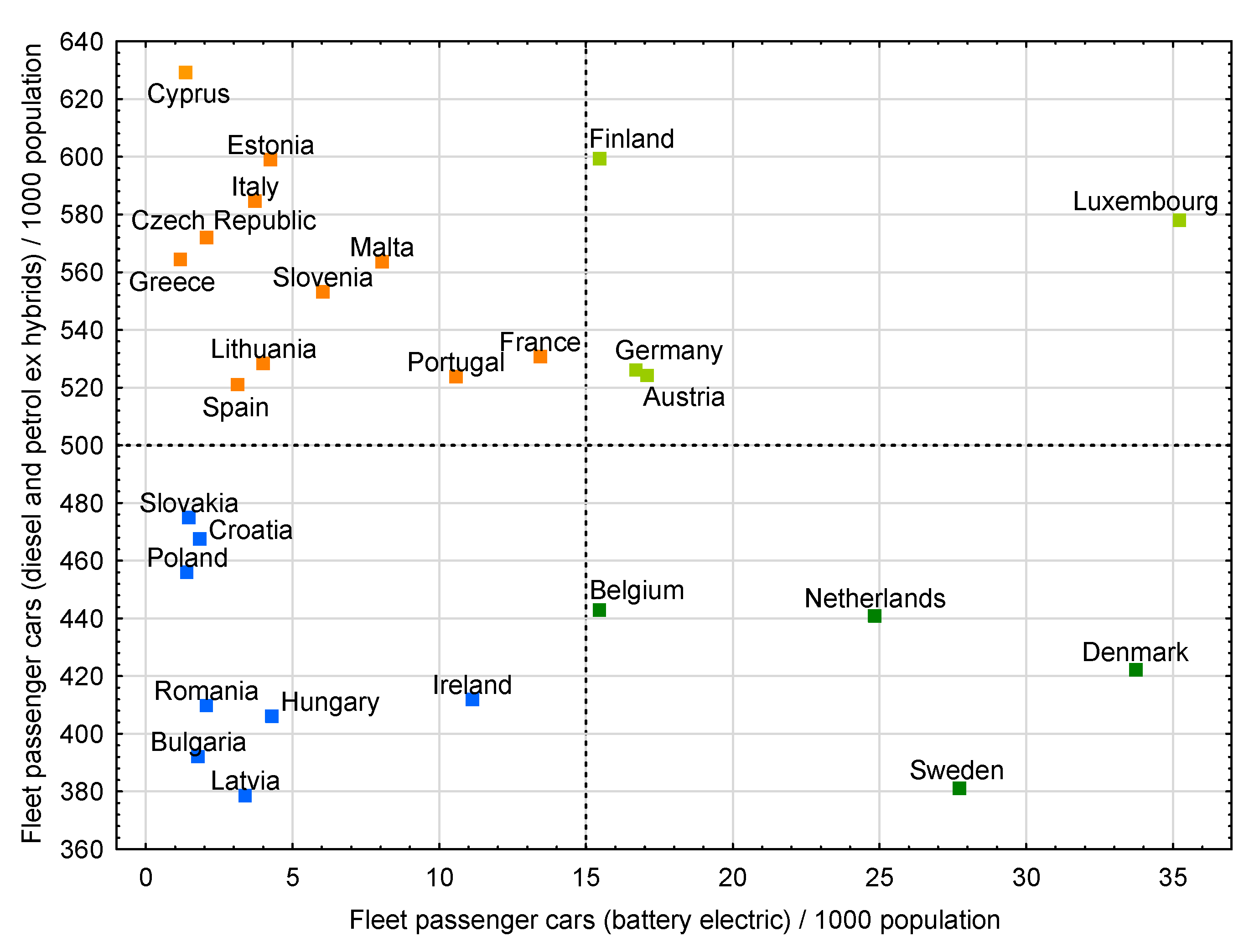
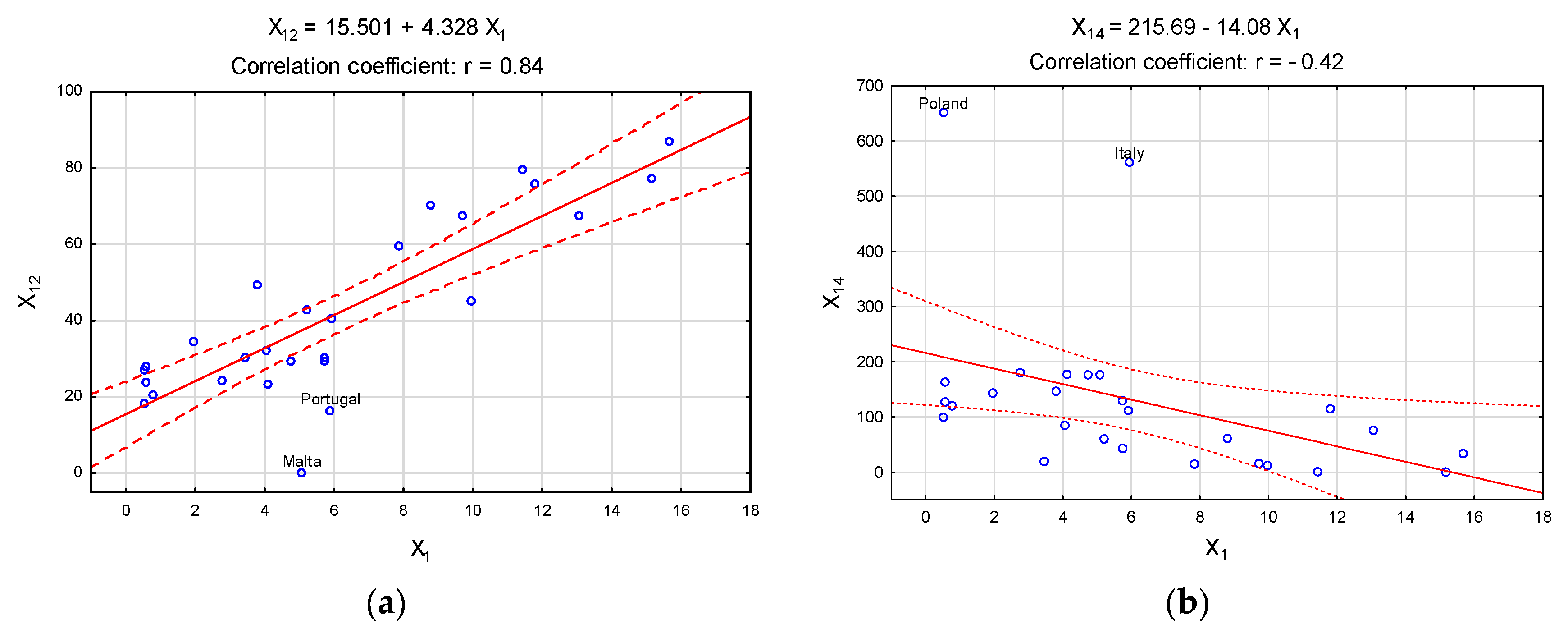
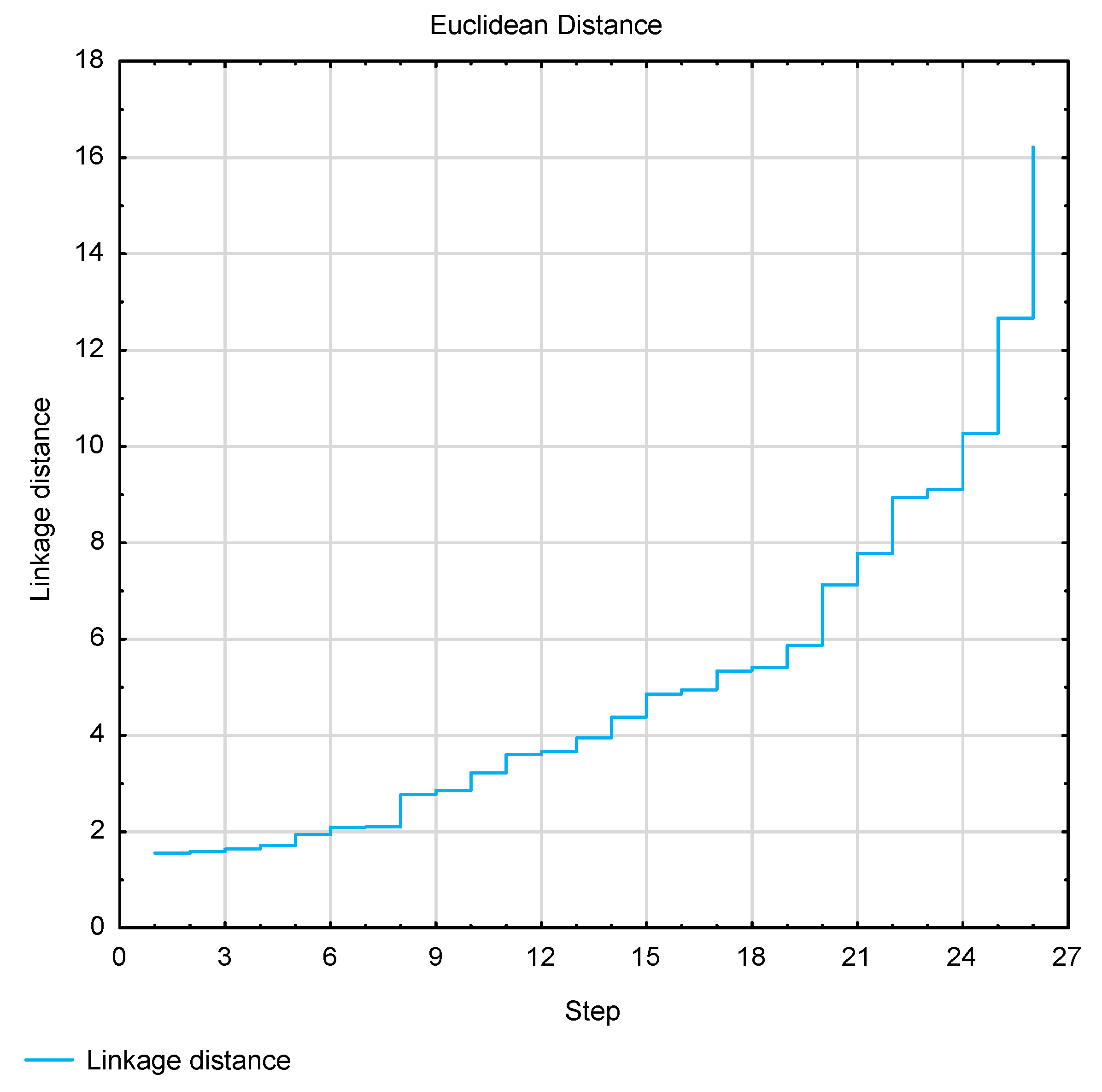
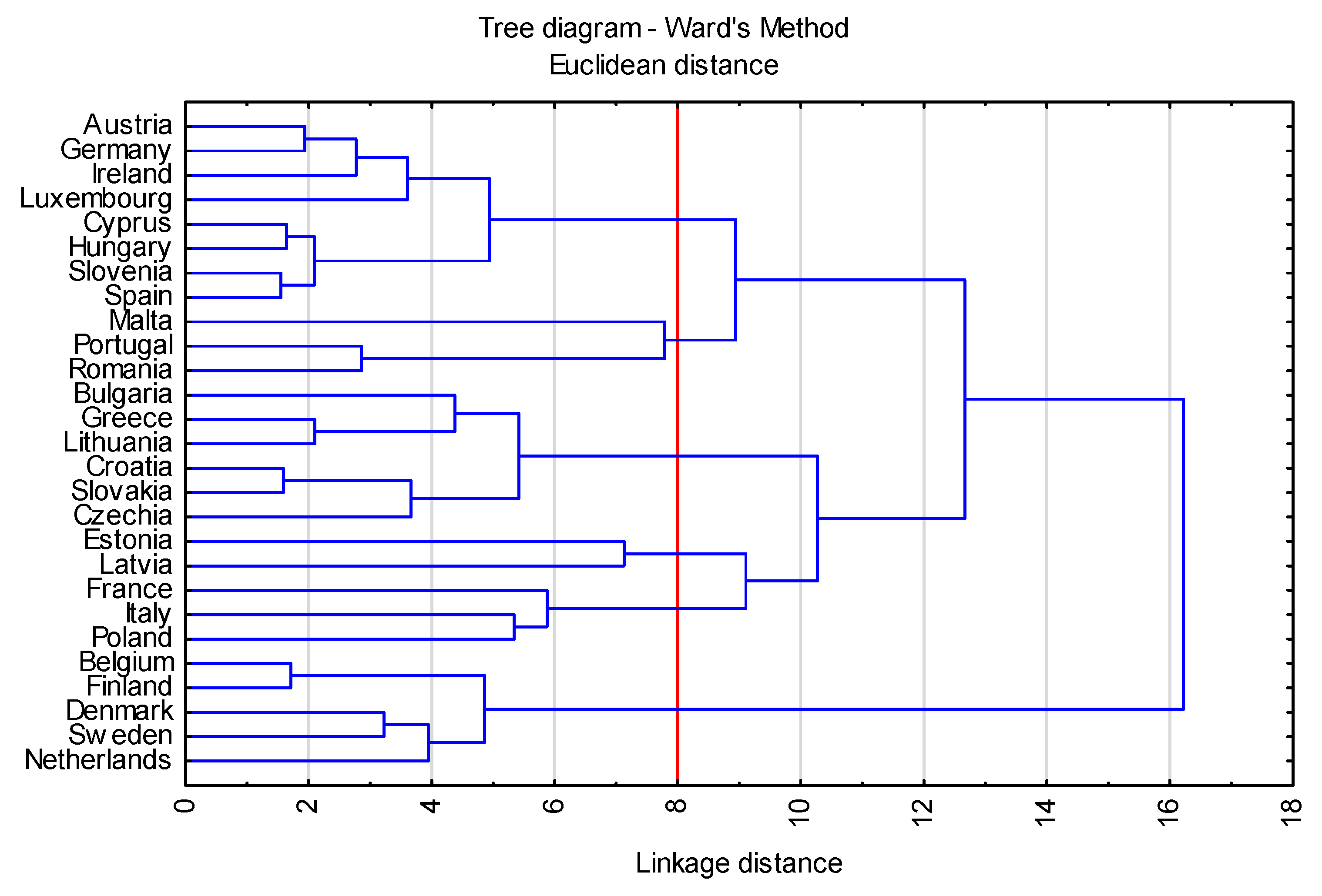

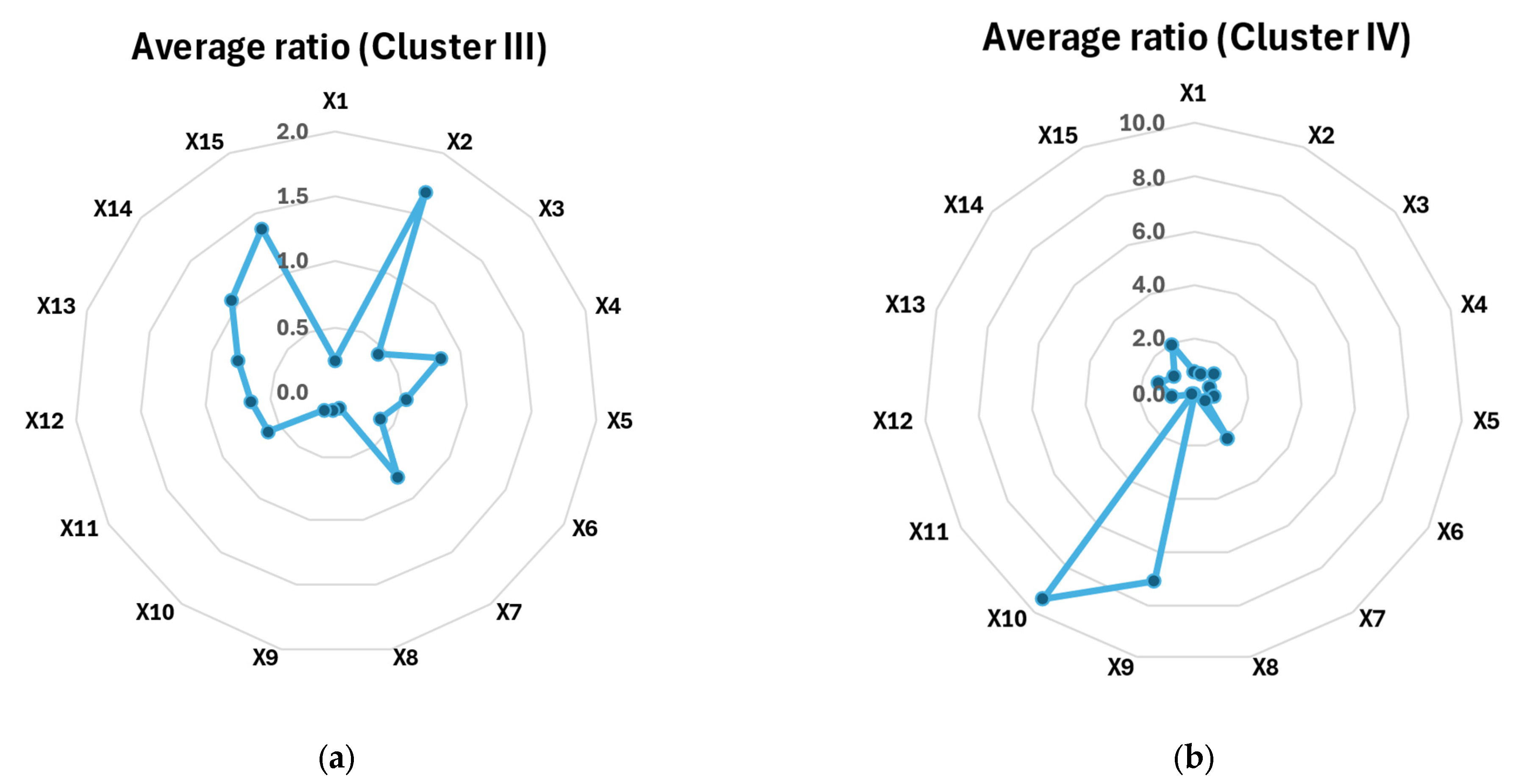
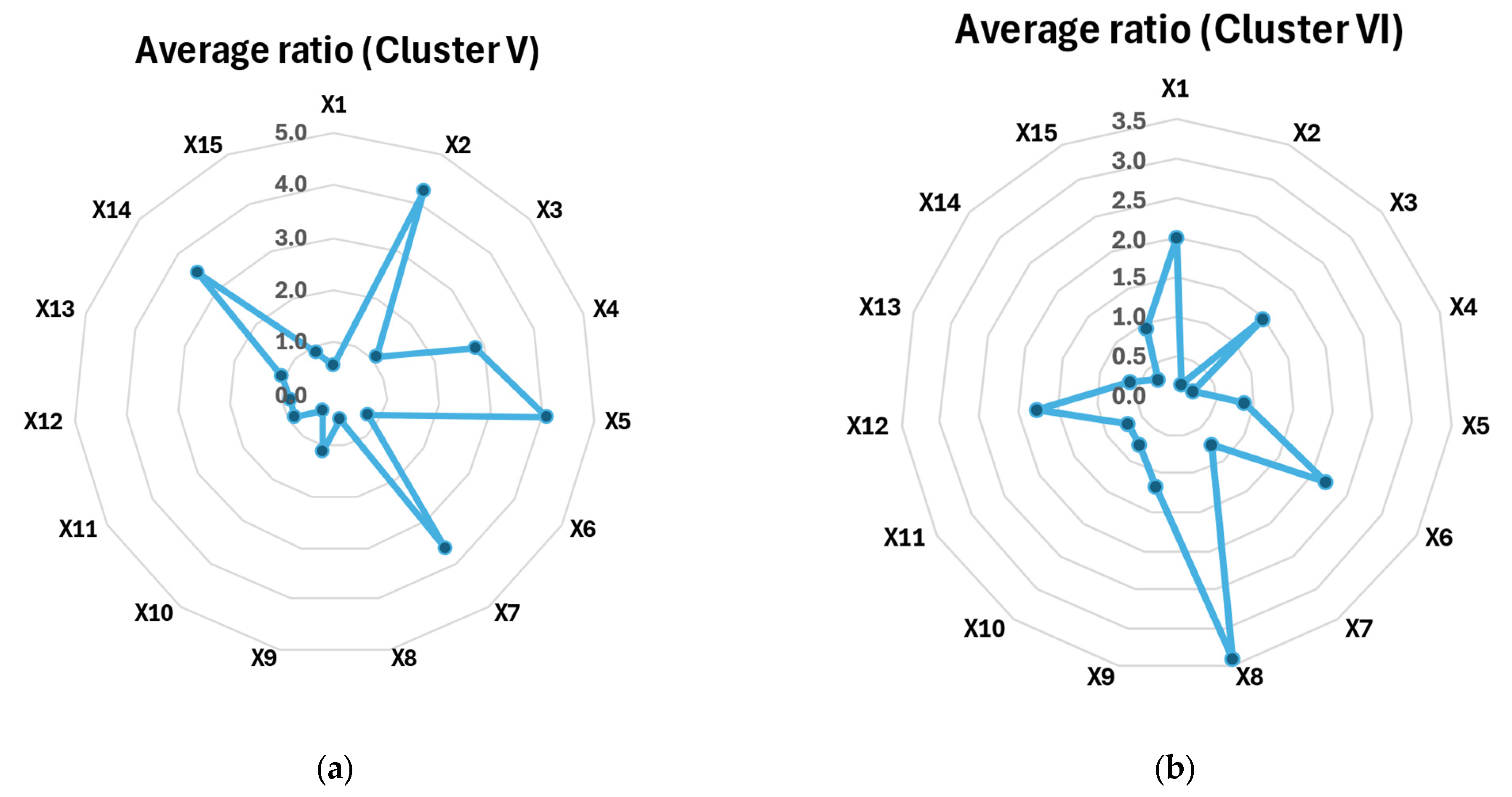
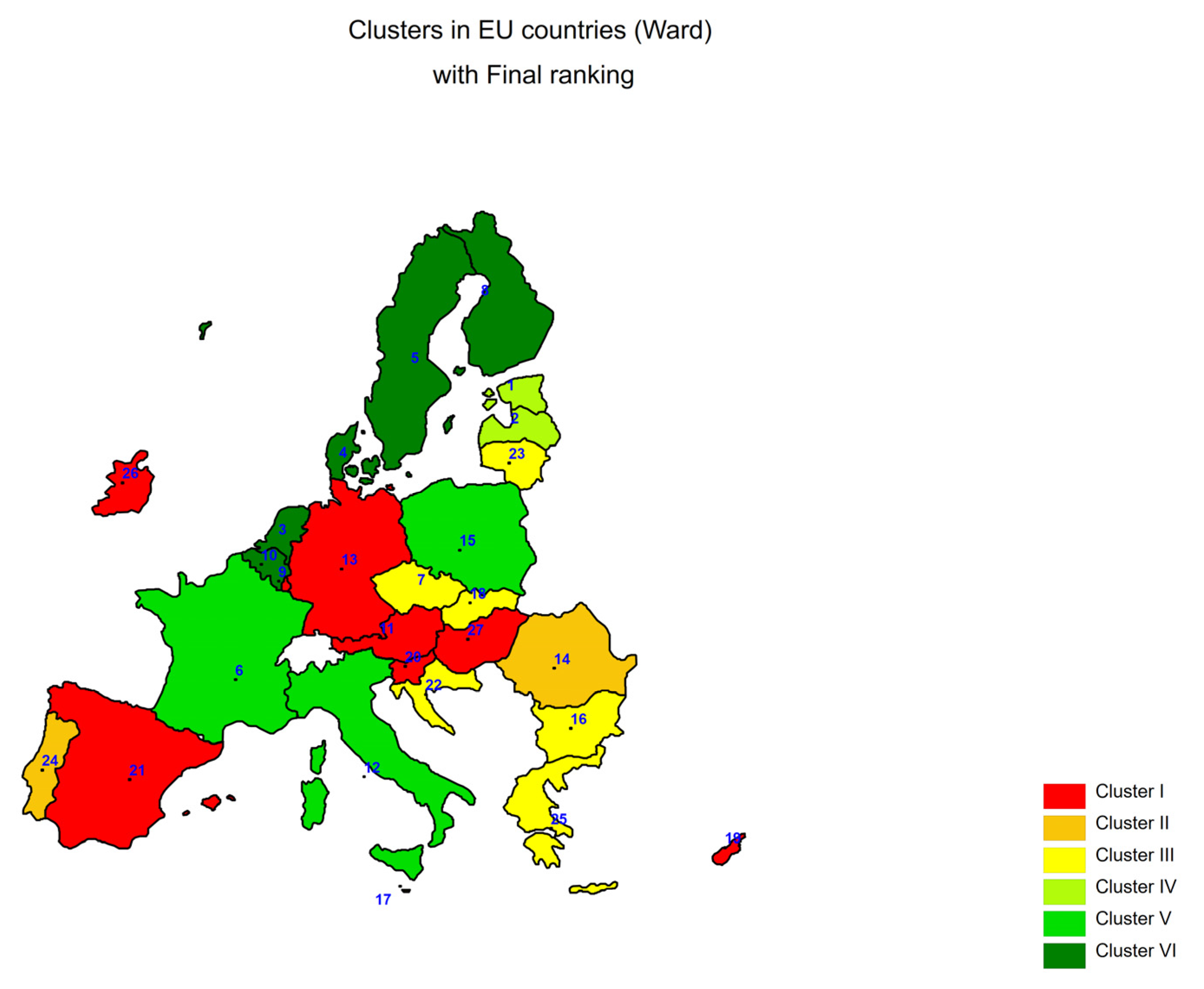
| Type of Vehicle | Advantages | Disadvantages |
|---|---|---|
| Electric | no exhaust emissions, high energy efficiency, low operating costs | limited range and long charging time, problems with battery disposal, high CO2 emissions in battery production |
| Hybrid | lower fuel consumption, lower CO2 emissions, quiet operation, no need for charging, longer range than electric cars | higher production costs and higher price, lower fuel economy on fast routes, high servicing costs (battery, electrical systems) |
| Hydrogen | fast refueling (about 5 min), long range, no exhaust emissions | high hydrogen production costs, poorly developed refueling infrastructure, energy losses in hydrogen production |
| Biofuels | renewable energy source, reduction of CO2 emissions, can be used in traditional engines | exhaust emissions (lower than in fossil fuels), need to modify engines |
| Gas (CNG, LNG, LPG) | lower CO2 emissions, cheaper fuel than classic fossil fuels, cleaner combustion | still fossil fuel (lower emissions) limited number of refueling stations large fuel tanks required in vehicles |
| Solar | free renewable energy, no exhaust emissions | low efficiency (small panel area), dependence on weather conditions, high costs |
| Diagnostic Variable | AB | ||||||
|---|---|---|---|---|---|---|---|
| Fleet (passenger cars) as percentage of total fleet (BEV + PHEV) [%] | X1 | 6.11 | 5.20 | 0.51 | 15.67 | 4.50 | 73% |
| Fleet (passenger cars) as percentage of total fleet (LPG, CNG, LNG) [%] | X2 | 2.04 | 0.31 | 0.003 | 16.25 | 4.12 | 201% |
| New registrations (passenger cars) as percentage of total registrations (BEV + PHEV) [%] | X3 | 43.86 | 46.30 | 0.72 | 77.58 | 19.00 | 43% |
| New registrations (passenger cars) as percentage of total registrations (LPG, CNG, LNG) [%] | X4 | 1.82 | 0.54 | 0.00 | 12.22 | 3.01 | 165% |
| New registrations (passenger cars) as percentage of total registrations (H2) [%] | X5 | 0.0028 | 0.0002 | 0.00 | 0.02 | 0.01 | 182% |
| New registrations (vans and buses) as percentage of total new registrations (BEV + PHEV) [%] | X6 | 23.91 | 15.98 | 3.14 | 62.01 | 19.58 | 81% |
| New registrations (vans and buses) as percentage of total new registrations (LPG, CNG, LNG) [%] | X7 | 4.39 | 1.25 | 0.00 | 21.69 | 6.54 | 149% |
| New registrations (trucks) as percentage of total registrations (BEV + PHEV) [%] | X8 | 1.17 | 0.30 | 0.00 | 7.22 | 1.87 | 160% |
| New registrations (trucks) as percentage of total registrations (LPG, CNG, LNG) [%] | X9 | 2.79 | 0.33 | 0.00 | 39.61 | 7.77 | 278% |
| Year-over-year growth in recharging points (AC) [%] | X10 | 12.21 | 6.75 | −26.07 | 211.01 | 41.03 | 336% |
| AC recharging points (fast speed) as percentage of total (AC) recharging points [%] | X11 | 7.85 | 1.98 | 0.00 | 100.00 | 19.27 | 245% |
| DC recharging points (ultra-fast level 1 and level 2) as percentage of total (DC) recharging points [%] | X12 | 41.93 | 32.44 | 0.00 | 87.15 | 23.13 | 55% |
| Unrestricted accessibility (24/7) recharging points as percentage of total recharging points [%] | X13 | 66.33 | 70.36 | 22.33 | 96.04 | 21.94 | 33% |
| Number of LPG vehicles per LPG refueling point | X14 | 129.76 | 111.78 | 0.28 | 651.38 | 150.28 | 115% |
| AFIR (output/target) [%] | X15 | 295.39 | 302.87 | 12.12 | 619.53 | 134.31 | 45% |
| X1 | X2 | X3 | X4 | X5 | X6 | X7 | X8 | X9 | X10 | X11 | X12 | X13 | X14 | X15 | |
|---|---|---|---|---|---|---|---|---|---|---|---|---|---|---|---|
| X1 | 1 | −0.38 | 0.66 | −0.31 | −0.14 | 0.61 | −0.05 | 0.57 | 0.02 | 0.03 | −0.04 | 0.84 | −0.18 | −0.42 | −0.38 |
| X2 | −0.38 | 1 | −0.3 | 0.17 | 0.32 | −0.23 | 0.23 | −0.22 | 0 | −0.06 | −0.05 | −0.27 | −0.1 | 0.8 | 0.13 |
| X3 | 0.66 | −0.3 | 1 | −0.18 | 0.06 | 0.58 | −0.02 | 0.4 | 0.14 | 0.12 | 0.11 | 0.44 | −0.03 | −0.11 | −0.39 |
| X4 | −0.31 | 0.17 | −0.18 | 1 | 0.02 | 0.18 | 0.34 | −0.24 | 0.01 | −0.18 | −0.05 | −0.3 | 0.18 | 0.47 | 0 |
| X5 | −0.14 | 0.32 | 0.06 | 0.02 | 1 | −0.01 | 0.36 | 0.19 | −0.05 | 0.06 | −0.17 | 0.09 | 0.04 | 0.38 | −0.05 |
| X6 | 0.61 | −0.23 | 0.58 | 0.18 | −0.01 | 1 | −0.13 | 0.51 | −0.08 | −0.03 | −0.09 | 0.55 | −0.32 | −0.16 | −0.26 |
| X7 | −0.05 | 0.23 | −0.02 | 0.34 | 0.36 | −0.13 | 1 | −0.06 | 0.34 | 0.14 | −0.1 | 0.02 | 0.07 | 0.41 | 0.23 |
| X8 | 0.57 | −0.22 | 0.4 | −0.24 | 0.19 | 0.51 | −0.06 | 1 | −0.02 | −0.05 | −0.05 | 0.65 | −0.32 | −0.28 | −0.16 |
| X9 | 0.02 | 0 | 0.14 | 0.01 | −0.05 | −0.08 | 0.34 | −0.02 | 1 | 0.03 | −0.11 | −0.05 | 0.02 | 0.04 | 0.42 |
| X10 | 0.03 | −0.06 | 0.12 | −0.18 | 0.06 | −0.03 | 0.14 | −0.05 | 0.03 | 1 | −0.06 | 0.05 | 0.16 | −0.09 | 0.38 |
| X11 | −0.04 | −0.05 | 0.11 | −0.05 | −0.17 | −0.09 | −0.1 | −0.05 | −0.11 | −0.06 | 1 | −0.35 | 0.23 | 0.12 | −0.42 |
| X12 | 0.84 | −0.27 | 0.44 | −0.3 | 0.09 | 0.55 | 0.02 | 0.65 | −0.05 | 0.05 | −0.35 | 1 | −0.33 | −0.41 | −0.11 |
| X13 | −0.18 | −0.1 | −0.03 | 0.18 | 0.04 | −0.32 | 0.07 | −0.32 | 0.02 | 0.16 | 0.23 | −0.33 | 1 | 0.16 | −0.07 |
| X14 | −0.42 | 0.8 | −0.11 | 0.47 | 0.38 | −0.16 | 0.41 | −0.28 | 0.04 | −0.09 | 0.12 | −0.41 | 0.16 | 1 | 0.08 |
| X15 | −0.38 | 0.13 | −0.39 | 0 | −0.05 | −0.26 | 0.23 | −0.16 | 0.42 | 0.38 | −0.42 | −0.11 | −0.07 | 0.08 | 1 |
| Clusters (k) | Davies–Bouldin [77] (min) | Baker-Hubert [78] (max) | Hubert-Levine [79] (min) | Tibshirani, Walther, and Hastie (GAP) [80] min (k) where |
|---|---|---|---|---|
| 2 | 1.42 | 0.26 | 0.47 | −0.0124 |
| 3 | 1.94 | 0.32 | 0.43 | −0.0277 |
| 4 | 1.73 | 0.52 | 0.36 | −0.0453 |
| 5 | 1.45 | 0.62 | 0.38 | −0.0087 |
| 6 | 1.32 | 0.75 | 0.29 | 0.0197 |
| 7 | 1.09 | 0.79 | 0.36 | 0.0008 |
| 8 | 0.93 | 0.82 | 0.44 | 0.0664 |
| Ward’s Method | K-Means Method | |
|---|---|---|
| Group I | Austria, Germany, Ireland, Luxembourg, Cyprus, Hungary, Slovenia, and Spain | Austria, Cyprus, Estonia, Hungary, Ireland, Lithuania, Slovenia, and Spain |
| Group II | Malta, Portugal, and Romania | Malta, Portugal, and Romania |
| Group III | Bulgaria, Greece, Lithuania, Croatia, Slovakia, and The Czech Republic | Bulgaria, Croatia, The Czech Republic, Greece, Latvia, and Slovakia |
| Group IV | Estonia and Latvia | Belgium, Finland, Germany, and Luxembourg |
| Group V | France, Italy and Poland | France, Italy, and Poland |
| Group VI | Denmark, Sweden, the Netherlands, Finland, and Belgium | Denmark, the Netherlands, and Sweden |
| Country | TS1 | R1 | Country | TS2 | R2 | Country | TS3 | R3 | Country | TSM | RM | RF |
|---|---|---|---|---|---|---|---|---|---|---|---|---|
| Netherlands | 0.483 | 1 | Estonia | 0.417 | 1 | Estonia | 0.834 | 1 | Estonia | 0.563 | 2.33 | 1 |
| Sweden | 0.462 | 2 | Latvia | 0.385 | 2 | Latvia | 0.747 | 2 | Latvia | 0.519 | 3.33 | 2 |
| Denmark | 0.441 | 3 | Poland | 0.347 | 3 | Slovakia | 0.694 | 3 | Netherlands | 0.468 | 7.00 | 3 |
| Luxembourg | 0.439 | 4 | France | 0.330 | 4 | Czech Republic | 0.680 | 4 | Denmark | 0.448 | 8.67 | 4 |
| Estonia | 0.437 | 5 | Malta | 0.320 | 5 | Croatia | 0.645 | 5 | Sweden | 0.453 | 8.67 | 5 |
| Latvia | 0.424 | 6 | Italy | 0.314 | 6 | Austria | 0.644 | 6 | France | 0.427 | 10.67 | 6 |
| France | 0.422 | 7 | Netherlands | 0.306 | 7 | Slovenia | 0.636 | 7 | Czech Republic | 0.424 | 11.00 | 7 |
| Finland | 0.419 | 8 | Sweden | 0.300 | 8 | Greece | 0.630 | 8 | Finland | 0.422 | 11.33 | 8 |
| Italy | 0.418 | 9 | Denmark | 0.294 | 9 | Bulgaria | 0.629 | 9 | Luxembourg | 0.407 | 12.00 | 9 |
| Germany | 0.401 | 10 | Romania | 0.262 | 10 | Lithuania | 0.628 | 10 | Belgium | 0.411 | 13.00 | 10 |
| Belgium | 0.395 | 11 | Bulgaria | 0.248 | 11 | Finland | 0.628 | 11 | Austria | 0.399 | 13.33 | 11 |
| Romania | 0.388 | 12 | Czech Republic | 0.247 | 12 | Belgium | 0.626 | 12 | Italy | 0.359 | 13.67 | 12 |
| Poland | 0.382 | 13 | Germany | 0.244 | 13 | Netherlands | 0.616 | 13 | Germany | 0.400 | 14.00 | 13 |
| Austria | 0.367 | 14 | Luxembourg | 0.221 | 14 | Denmark | 0.610 | 14 | Romania | 0.396 | 14.00 | 14 |
| Portugal | 0.361 | 15 | Finland | 0.219 | 15 | Cyprus | 0.607 | 15 | Poland | 0.325 | 14.33 | 15 |
| Malta | 0.360 | 16 | Belgium | 0.213 | 16 | Sweden | 0.599 | 16 | Bulgaria | 0.389 | 15.00 | 16 |
| Czech Republic | 0.346 | 17 | Portugal | 0.208 | 17 | Spain | 0.595 | 17 | Malta | 0.365 | 15.33 | 17 |
| Spain | 0.340 | 18 | Cyprus | 0.196 | 18 | Luxembourg | 0.562 | 18 | Slovakia | 0.387 | 16.67 | 18 |
| Cyprus | 0.338 | 19 | Spain | 0.190 | 19 | Germany | 0.556 | 19 | Cyprus | 0.380 | 17.33 | 19 |
| Hungary | 0.328 | 20 | Austria | 0.188 | 20 | Romania | 0.537 | 20 | Slovenia | 0.372 | 18.00 | 20 |
| Slovenia | 0.321 | 21 | Ireland | 0.181 | 21 | France | 0.529 | 21 | Spain | 0.375 | 18.00 | 21 |
| Ireland | 0.318 | 22 | Lithuania | 0.177 | 22 | Hungary | 0.526 | 22 | Croatia | 0.366 | 18.33 | 22 |
| Lithuania | 0.313 | 23 | Slovakia | 0.170 | 23 | Ireland | 0.521 | 23 | Lithuania | 0.373 | 18.33 | 23 |
| Slovakia | 0.296 | 24 | Croatia | 0.168 | 24 | Portugal | 0.493 | 24 | Portugal | 0.354 | 18.67 | 24 |
| Bulgaria | 0.289 | 25 | Hungary | 0.168 | 25 | Malta | 0.414 | 25 | Greece | 0.352 | 20.67 | 25 |
| Croatia | 0.286 | 26 | Slovenia | 0.160 | 26 | Italy | 0.346 | 26 | Ireland | 0.340 | 22.00 | 26 |
| Greece | 0.269 | 27 | Greece | 0.158 | 27 | Poland | 0.246 | 27 | Hungary | 0.341 | 22.33 | 27 |
Disclaimer/Publisher’s Note: The statements, opinions and data contained in all publications are solely those of the individual author(s) and contributor(s) and not of MDPI and/or the editor(s). MDPI and/or the editor(s) disclaim responsibility for any injury to people or property resulting from any ideas, methods, instructions or products referred to in the content. |
© 2025 by the authors. Licensee MDPI, Basel, Switzerland. This article is an open access article distributed under the terms and conditions of the Creative Commons Attribution (CC BY) license (https://creativecommons.org/licenses/by/4.0/).
Share and Cite
Chudy-Laskowska, K.; Chudy, M.; Pisula, J.; Pisula, T. Taxonomical Analysis of Alternative Energy Sources Application in Road Transport in the European Union Countries. Energies 2025, 18, 4228. https://doi.org/10.3390/en18164228
Chudy-Laskowska K, Chudy M, Pisula J, Pisula T. Taxonomical Analysis of Alternative Energy Sources Application in Road Transport in the European Union Countries. Energies. 2025; 18(16):4228. https://doi.org/10.3390/en18164228
Chicago/Turabian StyleChudy-Laskowska, Katarzyna, Maciej Chudy, Jadwiga Pisula, and Tomasz Pisula. 2025. "Taxonomical Analysis of Alternative Energy Sources Application in Road Transport in the European Union Countries" Energies 18, no. 16: 4228. https://doi.org/10.3390/en18164228
APA StyleChudy-Laskowska, K., Chudy, M., Pisula, J., & Pisula, T. (2025). Taxonomical Analysis of Alternative Energy Sources Application in Road Transport in the European Union Countries. Energies, 18(16), 4228. https://doi.org/10.3390/en18164228






